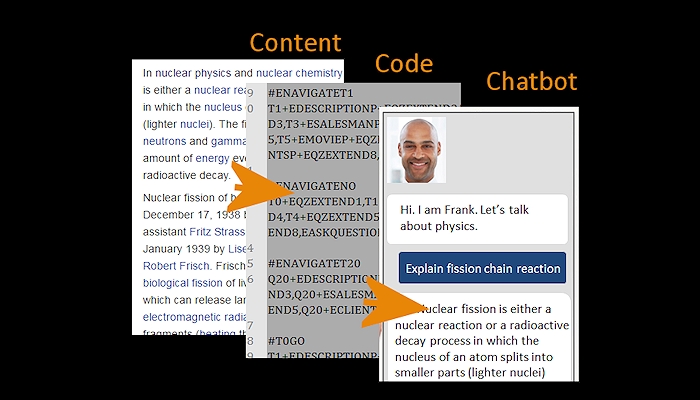If you heard AI systems that write their own computer codes, here is an example from exClone. The exclone’s platform is capable of taking any text, turn it into a special code (called CHATMATRIX), then spit out a chatbot that represents the content in a dialogue style. All in single step, with a push of a button.
The content is to be entered by subject matter experts in any particular topic. Hence the platform is called the Cloning Platform implying “digital cloning” of expertise. And the expertise can be anything, as simple as how to build a kite as long as it is articulated well. In this single step process, no coding is required to produce a chatbot.
The chatbots produced with this system have two primary functions: (1) Provide answers through presentations like how an expert would do by navigation options, (2) Provide answers to impromptu questions at any time during the conversation. There are bunch of secondary functions that make the whole experience human-like.
Machine Learning Similar to Human Learning
The human brain learns new knowledge while reading. As we all know, this process is very quick. The way to test learning is whether the person can answer questions about the sentences she/he read. exClone’s machine learning (ML) process works with the same principle, reading content and being able to answer questions. The automated step of creating a code for a given content is the byproduct of this machine learning process.
The editorial effort to create a chatbot involves few other choices by the expert. Some of these options include dialogue behavior (templates) that implement different objectives such as sales, help desk, advice, onboarding, surveying, etc. If you would like to experience the Cloning Platform, click here for free trial.
CHATMATRIX: A New Programming Language for Chatbots
Although the ML process creates a code for a given content (and template), the developers have a choice to add advanced functions and behaviors by further coding using the CHATMATRIX language. Bypassing the automation step, an entirely new chatbot can also be created. This high level language has the following features:
- The language is comprised of predefined NLP functions for detecting user’s comments and predefined ML functions to generate response to the user.
- Each statement handles not only the current exchange, but also the conversations took place N steps back. This enables strategizing the chatbot’s response based on history.
- Each statement evaluates the availability of all possible response options, then chose the best one.
If you would like to learn more about CHATMATRIX, please drop a note below in the comment section.
Detecting Emotions is Key to Chatbot Performance
One of the advantages of CHATMATRIX is its ability to detect sentiments in user responses which leads to formulating emotions based on the short history of the conversation. Emotions are detected by the density of the sentiments during the conversational steps. This may seem like a humanizing effect of the chatbot experience, which is true in one sense. However, emotions are very useful for business purposes because it becomes a tool to filter out genuine users (sales leads for example) from people with no intention to engage in business.
Detecting emotions like satisfaction, confusion, boredom, curiosity, and anger allows strategic moves in dialogue flow. If the user is satisfied, chatbot can offer more options, or ask user’s contact information. If the user is confused, chatbot can ask the source of confusion. Many different strategies can be implemented based on the objective. Finally, conversation logs with emotion markers provides highly insightful information about the clientele.
————–
Join our CHATBOTS linkedin group
Follow exClone in Linkedin or on Facebook
Cloning Platform, click here for free trial.
For CHATMATRIX inquiries, drop a message.



